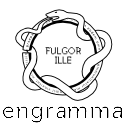Mnemosyne Atlas 5
Tipologie di preformazioni antiche
2. Dalla Magna Mater alla Mater dolorosa: figure femminili del pathos dionisiaco
Il repertorio di impronte del pathos (panico, difesa, furia, disperazione; tema del ratto e del sacrificio: cfr. tav. 6) declinato nelle figure femminili del mito: madre archetipica (Cibele); madre defraudata (Niobe); madre annientatrice (Medea); donna infuriata (Menade); donna in fuga, Proserpina, Mirra); figura luttuosa (Alcesti, Protesilao, Meleagro).
Types of ancient pre-coinages
2. From the Magna Mater to the Mater Dolorosa: female figures of Dionysiac pathos
The repertoire of emotional imprints (panic, defence, fury, despair; themes of abduction and sacrifice: see Panel 6) embodied in mythical female figures: archetypal mother (Cybele); dispossessed mother (Niobe); murderous mother (Medea); frenzied woman (Maenad); fleeing woman (Proserpine, Myrrha); grieving figure (Alcestis, Protesilaos, Meleager).

Appunti di Aby Warburg (1929)
Sarkoph. Tragisch
Sarcofagi tragici.
Appunti di Aby Warburg e collaboratori (1929)
Antike Vorprägungen
Magna mater, Kybele. Beraubte Mutter. (Niobe, Flucht und Schrecken). Vernichtende Mutter. Rasende (beleidigte) Frau. (Mänade, Orpheus, Pentheus). Klage um den Toten (Sohn!). Übergang: Unterweltsvorstellung (Raub d. Proserpina). Griff nach d. Kopf (Mänade, Kassandra, Priesterin! [Tafel 6]).
Preconiazioni antiche
Magna Mater, Cibele. Madre derubata. (Niobe, fuga e terrore). Madre annientatrice. Donna furiosa (oltraggiata). (Menade, Orfeo, Penteo). Lamentazione sul morto (Figlio!). Passaggio: rappresentazione del mondo infero (ratto di Proserpina). Afferrare per la testa (Menade, Cassandra, Sacerdotessa! [tavola 6]).
Appunti di Gertrud Bing (1940 ca)
Hohle der Magna Mater. Niobe – beraubte (und bestrafte) Mutter. Es ist Apoll der ihre Kinder tötel! Der Pädagoge hängt hier als Vorbild für den Pollaiuolo – David. Myrrha, die von ihren eigenen Vater vergewaltigt wird im Typus der klagend irrenden Niobe. Medea-rasend, auf d. Schlangen wagen mit ihrer Kindern, brütend – ohne Geste, (an R’dr denken!) Die Frau gegen den Mann: Orpheus, Pentheus. O. wird erschlagen, weiler die Frau verschmäht – P. weiler die Mänaden bei ihrer dionysischen Ra – sereien beobachtet. Toter Klage + Toter Bestattung. Pluto, Gott der Unterwelt, raubt Proserpina, die dann zur Göttin der sich immer erneuern den Natur wird. Was ist die Darstellung auf dem Krater?
Grotta della Magna Mater. Niobe – madre defraudata (e punita). È Apollo che uccide i suoi figli! Il pedagogo è presente qui come modello per il David del Pollaiuolo. Mirra, che viene violentata dal proprio padre, nel tipo della Niobe che fugge piangente. Medea furiosa, sul carro trainato da serpenti con i propri figli, nell’atto di meditare – senza gestualità (si pensi a Rembrandt!). La donna contro l’uomo: Orfeo, Penteo. Orfeo viene ucciso, perché rifiuta la donna – Penteo perché spia le Menadi nella loro frenesia dionisiaca. Lamentazione sul morto + sepoltura del morto. Plutone, dio degli Inferi, rapisce Proserpina, che così diventa la dea della natura in continuo rinnovamento. Che cosa è la raffigurazione sul cratere?
Letture di approfondimento
♦ Progetto Mnemosyne. Prototipo per una mostra sull'Atlante di Aby Warburg, Tavola 5, “La Rivista di Engramma” 26, luglio/agosto 2003 [IMPAGINAZIONE ORIGINALE].
♦ Seminario Mnemosyne, Letture grafiche di Tavola 5, “La Rivista di Engramma” 1, settembre 2000 [IMPAGINAZIONE ORIGINALE].
Altre letture
♦ K. Mazzucco, Tavola 5, in Camere con vista. Aby Warburg, Firenze e il laboratorio delle immagini, Catalogo della mostra (Firenze, Gallerie degli Uffizi, 19 settembre / 10 dicembre 2023), a cura di M. Faietti, E.D. Schmidt, G. Targia, G. Wolf et al., Firenze 2023, 244-247.
Notes by Aby Warburg (1929)
Sarkoph. Tragisch
Tragic sarcophagi.
Notes by Aby Warburg and coll. (1929)
Antike Vorprägungen
Magna mater, Kybele. Beraubte Mutter. (Niobe, Flucht und Schrecken). Vernichtende Mutter. Rasende (beleidigte) Frau. (Mänade, Orpheus, Pentheus). Klage um den Toten (Sohn!). Übergang: Unterweltsvorstellung (Raub d. Proserpina). Griff nach d. Kopf (Mänade, Kassandra, Priesterin! [Tafel 6]).
Precoinages from Antiquity
The Magna Mater, Cybele. Bereaved mother. (Niobe, flight and fear). Destructive mother. Frenzied (insulted) woman. (Maenad, Orpheus, Penteus). Lament for a dead man (NB her son). Transition: conception of the underwold (Rape of Proserpina). Grasping at the head (maenad, Cassandra,and priestess [panel 6]).
Notes by Gertrud Bing (ca. 1940)
Hohle der Magna Mater. Niobe – beraubte (und bestrafte) Mutter. Es ist Apoll der ihre Kinder tötel! Der Pädagoge hängt hier als Vorbild für den Pollaiuolo – David. Myrrha, die von ihren eigenen Vater vergewaltigt wird im Typus der klagend irrenden Niobe. Medea-rasend, auf d. Schlangen wagen mit ihrer Kindern, brütend – ohne Geste, (an R’dr denken!) Die Frau gegen den Mann: Orpheus, Pentheus. O. wird erschlagen, weiler die Frau verschmäht – P. weiler die Mänaden bei ihrer dionysischen Ra – sereien beobachtet. Toter Klage + Toter Bestattung. Pluto, Gott der Unterwelt, raubt Proserpina, die dann zur Göttin der sich immer erneuern den Natur wird. Was ist die Darstellung auf dem Krater?
Cave of the Magna Mater. Niobe – defrauded (and punished) mother. It is Apollo who kills his children! The pedagogue is present here as a model for Pollaiuolo’s David. Myrrha, who is raped by her own father, in the type of Niobe who flees weeping. The furious Medea, on the chariot pulled by snakes with her children, in the act of meditating – without gestures (Rembrandt in mind!). Woman against man: Orpheus, Pentheus. Orpheus is killed for rejecting the woman – Pentheus for spying on the Maenads in their Dionysian frenzy. Lamentation over the dead + burial of the dead. Pluto, the god of the Underworld, abducts Proserpine, who thus becomes the goddess of nature in constant renewal. What is the depiction on the crater?
Further Readings
♦ Progetto Mnemosyne. Prototipo per una mostra sull'Atlante di Aby Warburg, Tavola 5, “La Rivista di Engramma” 26, luglio/agosto 2003 [OLD LAYOUT].
♦ Seminario Mnemosyne, Letture grafiche di Tavola 5, “La Rivista di Engramma” 1, settembre 2000 [OLD LAYOUT].
Other Readings
♦ K. Mazzucco, Tavola 5, in Camere con vista. Aby Warburg, Firenze e il laboratorio delle immagini, Catalogo della mostra (Firenze, Gallerie degli Uffizi, 19 settembre / 10 dicembre 2023), a cura di M. Faietti, E.D. Schmidt, G. Targia, G. Wolf et al., Firenze 2023, 244-247.

1. Cibele, bassorilievo rupestre del tempio della Magna Mater sul monte Sipylos ad Magnesia (oggi Manisa, Lidia)
2. Giulio Bonasone, Giasone e Medea, acquaforte su rame dal rilievo di un sarcofago romano, sec. XVI
3. Ratto di Proserpina, marmo, frammento di un sarcofago romano, 140-150 d.C., Roma, Musei Vaticani, Galleria delle Statue
4. Figlia di Niobe, dal gruppo scultoreo dei Niobidi, marmo, copia romana da originale greco, IV-I sec. a.C., Firenze, Galleria degli Uffizi
5. Figlia di Niobe, cosiddetta Psyche, dal gruppo scultoreo dei Niobidi, marmo, copia romana da originale greco, IV-I sec. a.C., Firenze, Galleria degli Uffizi
6. Figlia di Niobe, cosiddetta Amazzone Colonna, marmo, rimaneggiamento romano di un originale greco, II sec. a.C., Roma, Palazzo Colonna
7. Storia di Medea, marmo, rilievo di un sarcofago romano, ca. 150 d.C., Berlin, Staatliche Museen, Antikesammlung
8. Alcesti morente, disegno (dettaglio de La morte di Alcesti, [cfr. fig. 10], da sarcofago romano perduto, già Cannes, Villa di Faustina, 160-170 d.C.), Codex Coburgensis, fol. 44, 1550-55, Coburg, Kupferstichkabinett der Kunstsammlungen der Veste Coburg, Hz 2 (da: C. Robert “Die antiken Sarkophagreliefs”, vol. III, 1, Berlin 1897, tav. 6, ill. 27)
9. Morte di Alcesti, disegno, da bassorilievo su sarcofago romano di Villa Albani, 150-175 d.C.
10. La morte di Alcesti, disegno, da sarcofago romano perduto, già Cannes Villa Faustina, 160-170 d.C., Codex Coburgensis, fol. 44, 1550-55, Coburg, Kupferstichkabinett der Kunstsammlungen der Veste Coburg, Hz 2 (da: C. Robert “Die antiken Sarkophagreliefs”, vol. III, 1, Berlin 1897, tav. 6, ill. 22)
11. Medea prima dell'assassinio dei figli, affresco, da Pompei, Casa dei Dioscuri, 62-79 d.C., Napoli, Museo Archeologico Nazionale
12. Morte di Penteo, affresco, 45-79 d.C., Pompei, Casa dei Vettii
13. Riproduzione grafica di La morte di Alcesti, [cfr. fig. 10], disegno da sarcofago romano perduto, già Cannes, Villa Faustina, 160-170 d.C., Codex Coburgensis, fol. 44, 1550-55, Coburg, Kupferstichkabinett der Kunstsammlungen der Veste Coburg, Hz 2 (da C. Robert “Die antiken Sarkophagreliefs”, vol. III, 1, Berlin 1897, tav. 6, ill. 22)
14. Storia di Protesilao e Laodamia, marmo, bassorilievo su sarcofago romano del 170 d.C., Roma, Musei Vaticani, Galleria dei Candelabri
15. Medea prima dell'assassinio dei figli, pittura parietale, da Ercolano, 45-79 d.C., Napoli, Museo Archeologico Nazionale
16. Morte di Orfeo, frammento di una kylix attica, 470-460 a.C., Atene, Museo Archeologico Nazionale (da Aby Warburg, Dürer und die italienische Antike, Hamburg 1905, tav. 1a)
17. Morte di Orfeo, stamnos attica a figure rosse, cosiddetto "Vaso da Nola", 450-425 a.C., Paris, Musée du Louvre (da: Aby Warburg, Dürer und die italienische Antike, Hamburg 1905, tav. 1b)
17a. Morte di Orfeo, stamnos attica a figure rosse, cosiddetto "Vaso da Chiusi", 450-425 a.C., disperso, già collezione Emil Braun (da Aby Warburg, Dürer und die italienische Antike, Hamburg 1905, tav. 1c)
18. Jacopo del Sellaio, Orfeo ed Euridice, pittura su cassone, 1471, Rotterdam, Museum Boijmans (da Aby Warburg, Dürer und die italienische Antike, Hamburg 1905, tav. 1d)
19. Morte di Meleagro, disegno, dal bassorilievo su sarcofago romano di Villa Albani, 170 d.C. Codex Coburgensis, fol. 99, 1550-55,, Coburg, Kupferstichkabinett der Kunstsammlungen der Veste Coburg, Hz 2 (da C. Robert “Die antiken Sarkophagreliefs”, vol. III, 1, Berin 1897, tav. 96, ill. 278)
20. Meleagro morente viene portato a casa, disegno dal bassorilievo su sarcofago romano perduto, già di Palazzo Barberini, 180-190 d.C., Codex Coburgensis, fol. 124, 1550-55, Coburg, Kupferstichkabinett der Kunstsammlungen der Veste Coburg, Hz 2 (da C. Robert “Die antiken Sarkophagreliefs”, vol. III, 1, Berin 1897, tav. 96, ill. 287)
21. Alcesti morente, marmo, bassorilievo sul sarcofago di Gaius Junius Euhodus e di Metilia, 160-170 d.C., Roma, Museo Chiaramonti
22. Licurgo vince una menade, cratere a volute, marmo, 30-20 a.C., Roma, Musei Vaticani, Gallerie dei Candelabri
23. Pedagogo, dal gruppo scultoreo dei Niobidi, marmo, copia romana da originale greco, IV-I sec. a.C., Firenze, Galleria degli Uffizi
24. Mirra fuggente, pittura parietale, da Tor Marancia, III sec. d.C., Roma, Musei Vaticani, Sala delle Nozze Aldobrandini
25. Morte di Penteo, frammento di bassorilievo romano su sarcofago, 170-190 d.C., Roma, Palazzo Giustiniani
26. Le menadi uccidono Penteo, disegno, dal coperchio del sarcofago di Tito Camurenus Myron del 150-160 d.C., Pisa, Camposanto (da O. Jahn, “Pentheus un die Mainaden”, Kiel 1841, tav. 3b)
27. Ratto di Proserpina, bassorilievo su sarcofago romano, 200-220 d.C., Roma, Musei Vaticani, Sala delle Muse
1. Cybele, rock carving of the Magna Mater temple on the Mount Sipylus ad Magnesia (actual Manisa, Lidia)
2. Giulio Bonasone, Jason and Medea, etching from a relief of a Roman sarcophagus, XVIth Century, London, The British Museum
3. Rape of Proserpina, marble fragment of a Roman sarcophagus, 140-150 A.C., Roma, Musei Vaticani, Gallerie delle Statue
4. Daughter of Niobe, from the sculpture group of the Niobidis, marble, Roman copy from a Greek original, IVth-Ist century B.C., Firenze, Galleria degli Uffizi
5. Daughter of Niobe, called Psyche, from the sculpture group of the Niobidis, marble, Roman copy from a Greek original, IVth-Ist century B.C., Firenze, Galleria degli Uffizi
6. Daughter of Niobe, called Amazon Colonna, marble, Roman rehash of a Greek original, 2nd century B.C., Roma, Palazzo Colonna
7. The history of Medea, marble, Roman sarcophagus relief, ca. 150 A.C., Berlin, Staatliche Museen, Antikesammlung
8. Dying Alcesis, drawing, detail of The death of Alcestis [cfr. fig. 10], reproduction of a bas-reliefs on Roman lost sarcophagus, from Cannes, Villa Faustina, 160-170 A.C., Codex Coburgensis, fol. 44, 1550-55, Coburg, Kupferstichkabinett der Kunstsammlungen der Veste Coburg, Hz 2 (from C. Robert “Die antiken Sarkophagreliefs”, vol. III, 1, Berlin 1897, tav. 6, ill. 27)
9. Death of Alcestis, drawing, of the bas-relief of the Roman sarcophagus of Villa Albani 150-175 A.C.
10. The death of Alcestis, drawing reproduction of a bas-reliefs on Roman lost sarcophagus, ex Cannes, Villa Faustina, 160-170 A.C., Codex Coburgensis, fol. 44, 1550-55, Coburg, Kupferstichkabinett der Kunstsammlungen der Veste Coburg, Hz 2 (from C. Robert “Die antiken Sarkophagreliefs”, vol. III, 1, Berlin 1897, tav. 6, ill.22)
11. Medea before the assassination of her children, fresco from Pompei, Casa dei Dioscuri, 62-79 A.C., Napoli, Museo Archeologico Nazionale
12. Death of Pentheus, fresco, 45-79 A.C., Pompei, Casa dei Vettii
13. Graphic reproduction from The death of Alcestis [cfr. fig. 10], drawing of a bas-reliefs on Roman lost sarcophagus, from Cannes, Villa Faustina, 160-170 A.C., Codex Coburgensis, fol. 44, 1550-55, Coburg, Kupferstichkabinett der Kunstsammlungen der Veste Coburg, Hz 2 (from C. Robert “Die antiken Sarkophagreliefs”, vol. III, 1, Berlin 1897, tav. 6, ill. 22)
14. History of Protesilaus and Laodamia, marble, bas-relief on the sarcophagus, 170 A.C., Roma, Musei Vaticani, Galleria dei Candelabri
15. Medea before the assassination of her children, parietal painting, from Herculaneum, 45-79 A.C., Napoli, Museo Archeologico Nazionale
16. Death of Orpheus, fragment of an Attic kylix, 470-460 B.C., Athens, National Archeological Museum (from Aby Warburg, Durer und die italienische Antike, Hamburg 1905, plate 1a)
17. Death of Orpheus, Attic red-figure stamnos, known as “Vaso da Nola”, 450-425 B.C., Paris, Musee du Louvre (from Aby Warburg, Durer und die italienische Antike, Hamburg 1905, plate 1b)
17a. Death of Orpheus, Attic red-figure stamnos, known as “Vaso da Chiusi”, 450-425 B.C., lost, ex Emil Braun collection (from Aby Warburg, Durer und die italienische Antike, Hamburg 1905, plate 1c)
18. Jacopo del Sellaio, Orpheus and Eurydice, painting on cassone, 1471, Rotterdam, Museum Boijmans (from Aby Warburg, Durer und die italienische Antike, Hamburg 1905, plate 1d)
19. Death of Meleager, drawing of the bas-relief of the Roman sarcophagus of Villa Albani, 170 A.C., Codex Coburgensis fol. 99, 1550-55, Coburg, Kupferstichkabinett der Kunstsammlungen der Veste Coburg, Hz 2 (from C. Robert “Die antiken Sarkophagreliefs”, vol. III, 1, Berin 1897, tav. 96, ill. 278)
20. Dying Meleager, drawing of the bas-relief of the lost Roman sarcophagus from Palazzo Barberini, 180-190 A.C., Codex Coburgensis, fol. 124, 1550-55, Coburg, Kupferstichkabinett der Kunstsammlungen der Veste Coburg, Hz 2 (da C. Robert “Die antiken Sarkophagreliefs”, vol. III, 1, Berin 1897, tav. 96, ill.287)
21. Dying Alcestis, marble, bas-relief on the sarcophagus of Gaius Junius Metilia, Euhodus, 160-170 A.C., Roma, Museo Chiaramonti
22. Lycourgus assaults a Maenad, volute krater, marble, 30-20 B.C., Roma, Musei Vaticani, Galleria dei Candelabri
23. The Pedagogue, from the sculpture group of the Niobidis, marble, Roman copy from a Greek original, IVth-Ist century B.C., Firenze, Galleria degli Uffizi
24. Myrrh fleeting, parietal painting, from Tor Marancia, 3rd century A.C., Roma, Musei Vaticani, Sala delle Nozze Aldobrandini
25. Death of Pentheus, marble, fragment of a bas-relief on a Roman sarcophagus, 170 -190 A.C., Roma Palazzo Giustiniani
26. The Maenads kill Pentheus, drawing from the cover of the sarcophagus of Tito Camurenus Myron dated 150-160 A.C., Pisa, Camposanto (from O. Jahn, “Pentheus un die Mainaden”, Kiel 1841, plate 3b)
27. Rape of Proserpina, bas-relief of a Roman sarcophagus, 200-220 A.C., Roma, Musei Vaticani, Sala delle Muse


5_1 | Cibele, bassorilievo rupestre del tempio della Magna Mater sul monte Sipylos ad Magnesia (oggi Manisa, Lidia).
5_1 |Cybele, rock carving of the Magna Mater temple on the Mount Sipylus ad Magnesia (actual Manisa, Lidia).
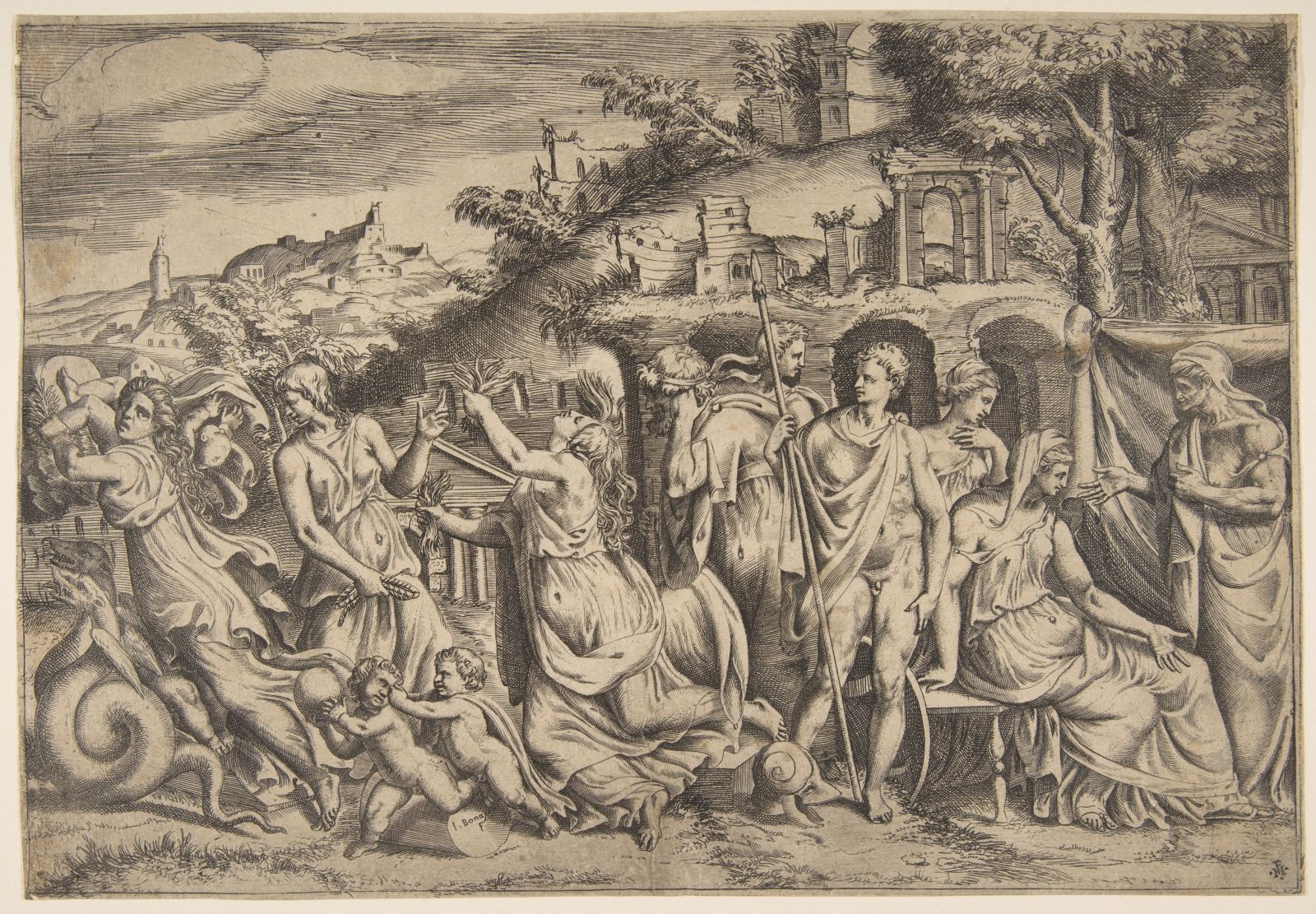
5_10 |Giulio Bonasone, Giasone e Medea, acquaforte su rame dal rilievo di un sarcofago romano, sec. XVI.
5_10 |Giulio Bonasone, Jason and Medea, etching from a relief of a Roman sarcophagus, XVIth Century, London, The British Museum.
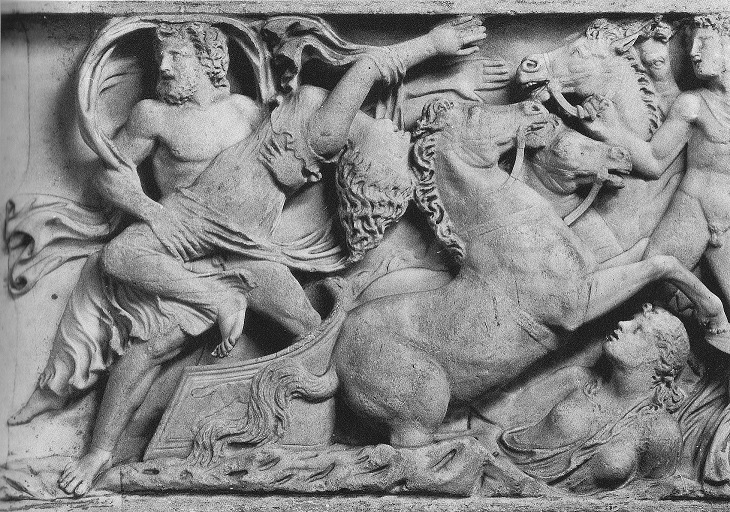
5_15 |Ratto di Proserpina, marmo, frammento di un sarcofago romano, 140-150 d.C., Roma, Musei Vaticani, Galleria delle Statue.
5_15 |Rape of Proserpina, marble fragment of a Roman sarcophagus, 140-150 A.C., Roma, Musei Vaticani, Gallerie delle Statue.
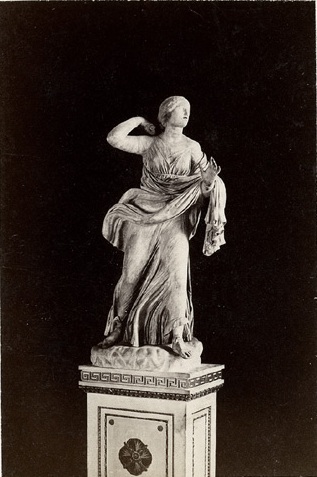
5_2 | Figlia di Niobe, dal gruppo scultoreo dei Niobidi, marmo, copia romana da originale greco, IV-I sec. a.C., Firenze, Galleria degli Uffizi.
5_2 | Daughter of Niobe, from the sculpture group of the Niobidis, marble, Roman copy from a Greek original, IVth-Ist century B.C., Firenze, Galleria degli Uffizi.
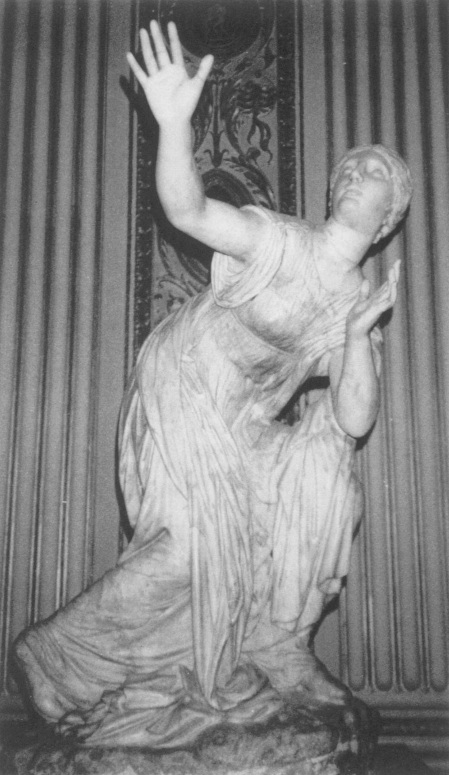
5_3 | Figlia di Niobe, cosiddetta Psyche, dal gruppo scultoreo dei Niobidi, marmo, copia romana da originale greco, IV-I sec. a.C., Firenze, Galleria degli Uffizi.
5_3 | Daughter of Niobe, called Psyche, from the sculpture group of the Niobidis, marble, Roman copy from a Greek original, IVth-Ist century B.C., Firenze, Galleria degli Uffizi.
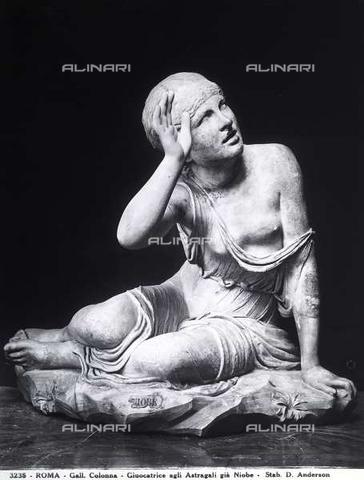
5_4 | Figlia di Niobe, cosiddetta Amazzone Colonna, marmo, rimaneggiamento romano di un originale greco, II sec. a.C., Roma, Palazzo Colonna.
5_4 | Daughter of Niobe, called Amazon Colonna, marble, Roman rehash of a Greek original, 2nd century B.C., Roma, Palazzo Colonna.

5_9 | Storia di Medea, marmo, rilievo di un sarcofago romano, ca. 150 d.C., Berlin, Staatliche Museen, Antikesammlung.
5_9 | The history of Medea, marble, Roman sarcophagus relief, ca. 150 A.C., Berlin, Staatliche Museen, Antikesammlung.
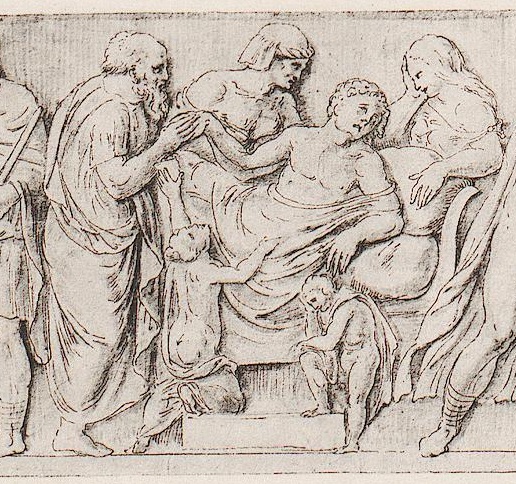
5_17b | Morte di Alcesti, disegno (dettaglio de La morte di Alcesti, [cfr. fig. 10], da sarcofago romano perduto, già Cannes, Villa di Faustina, 160-170 d.C.), Codex Coburgensis, fol. 44, 1550-55, Coburg, Kupferstichkabinett der Kunstsammlungen der Veste Coburg, Hz 2 (da C. Robert “Die antiken Sarkophagreliefs”, vol. III, 1, Berlin 1897, tav. 6, ill. 27).
5_17b | Dying Alcesis, drawing, detail of The death of Alcestis [cfr. fig. 10], reproduction of a bas-reliefs on Roman lost sarcophagus, from Cannes, Villa Faustina, 160-170 A.C., Codex Coburgensis, fol. 44, 1550-55, Coburg, Kupferstichkabinett der Kunstsammlungen der Veste Coburg, Hz 2 (from C. Robert “Die antiken Sarkophagreliefs”, vol. III, 1, Berlin 1897, tav. 6, ill. 27).

5_16 | Morte di Alcesti, disegno, da bassorilievo su sarcofago romano di Villa Albani, 150-175 d.C.
5_16 | Death of Alcestis, drawing, of the bas-relief of the Roman sarcophagus of Villa Albani 150-175 A.C.

5_17c | La morte di Alcesti, disegno, da sarcofago romano perduto, già Cannes Villa Faustina, 160-170 d.C., Codex Coburgensis, fol. 44, 1550-55, Coburg, Kupferstichkabinett der Kunstsammlungen der Veste Coburg, Hz 2 (da C. Robert “Die antiken Sarkophagreliefs”, vol. III, 1, Berlin 1897, tav. 6, ill. 22).
5_17c | The death of Alcestis, drawing reproduction of a bas-reliefs on Roman lost sarcophagus, ex Cannes, Villa Faustina, 160-170 A.C., Codex Coburgensis, fol. 44, 1550-55, Coburg, Kupferstichkabinett der Kunstsammlungen der Veste Coburg, Hz 2 (from C. Robert “Die antiken Sarkophagreliefs”, vol. III, 1, Berlin 1897, tav. 6, ill.22).
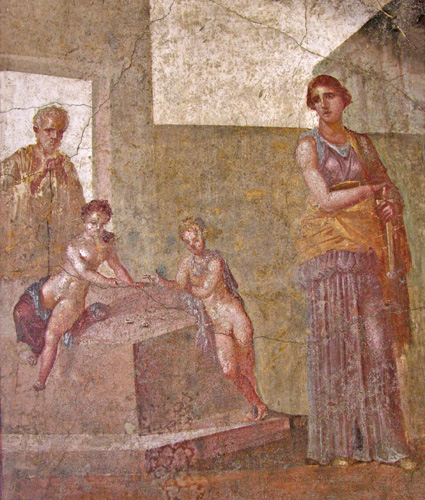
5_8 | Medea prima dell'assassinio dei figli, affresco, da Pompei, Casa dei Dioscuri, 62-79 d.C., Napoli, Museo Archeologico Nazionale.
5_8 | Medea before the assassination of her children, fresco from Pompei, Casa dei Dioscuri, 62-79 A.C., Napoli, Museo Archeologico Nazionale.
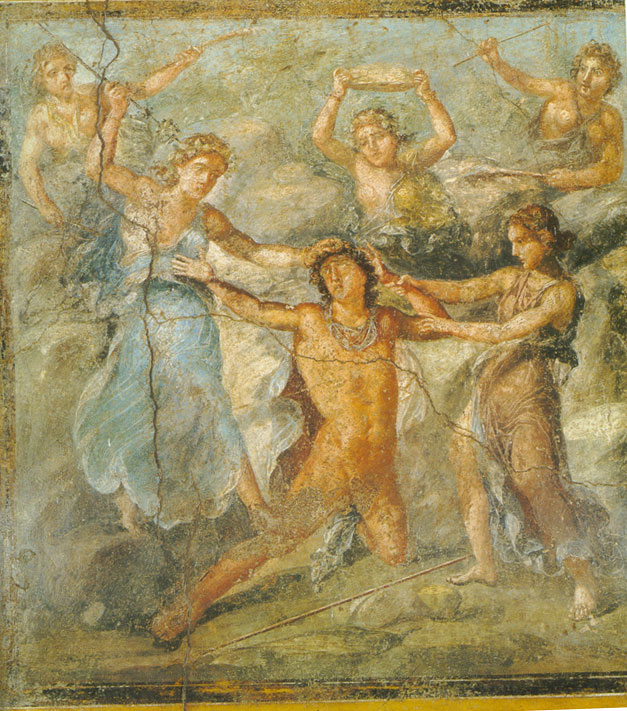
5_11 | Morte di Penteo, affresco, 45-79 d.C., Pompei, Casa dei Vettii.
5_11 | Death of Pentheus, fresco, 45-79 A.C., Pompei, Casa dei Vettii.

5_17a | Riproduzione grafica di La morte di Alcesti, [cfr. fig. 10], disegno da sarcofago romano perduto, già Cannes, Villa Faustina, 160-170 d.C., Codex Coburgensis, fol. 44, 1550-55, Coburg, Kupferstichkabinett der Kunstsammlungen der Veste Coburg, Hz 2 (da C. Robert “Die antiken Sarkophagreliefs”, vol. III, 1, Berlin 1897, tav. 6, ill. 22).
5_17a | Graphic reproduction from The death of Alcestis [cfr. fig. 10], drawing of a bas-reliefs on Roman lost sarcophagus, from Cannes, Villa Faustina, 160-170 A.C., Codex Coburgensis, fol. 44, 1550-55, Coburg, Kupferstichkabinett der Kunstsammlungen der Veste Coburg, Hz 2 (from C. Robert “Die antiken Sarkophagreliefs”, vol. III, 1, Berlin 1897, tav. 6, ill. 22).

5_18 | Storia di Protesilao e Laodamia, marmo, bassorilievo su sarcofago romano del 170 d.C., Roma, Musei Vaticani, Galleria dei Candelabri.
5_18 | History of Protesilaus and Laodamia, marble, bas-relief on the sarcophagus, 170 A.C., Roma, Musei Vaticani, Galleria dei Candelabri.

5_7 | Medea prima dell'assassinio dei figli, pittura parietale, da Ercolano, 45-79 d.C., Napoli, Museo Archeologico Nazionale.
5_7 | Medea before the assassination of her children, parietal painting, from Herculaneum, 45-79 A.C., Napoli, Museo Archeologico Nazionale.
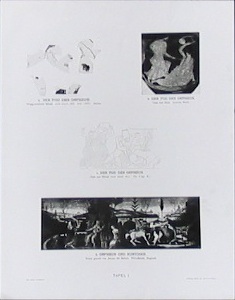
5_12.1 | Morte di Orfeo, frammento di una kylix attica, 470-460 a.C., Atene, Museo Archeologico Nazionale (da Aby Warburg, Dürer und die italienische Antike, Hamburg 1905, tav. 1a).
5_12.1 | 12.1 Death of Orpheus, kylix fragment, painted clay plate, 470-460 BC. Athens, National Archeological Museum.

5_12.2 | Morte di Orfeo, stamnos attica a figure rosse, cosiddetto "Vaso da Nola", 450-425 a.C., Paris, Musée du Louvre (da Aby Warburg, Dürer und die italienische Antike, Hamburg 1905, tav. 1b).
5_12.2 | Death of Orpheus, Attic red-figure stamnos, known as “Vaso da Nola”, 450-425 B.C., Paris, Musee du Louvre (from Aby Warburg, Durer und die italienische Antike, Hamburg 1905, plate 1b).
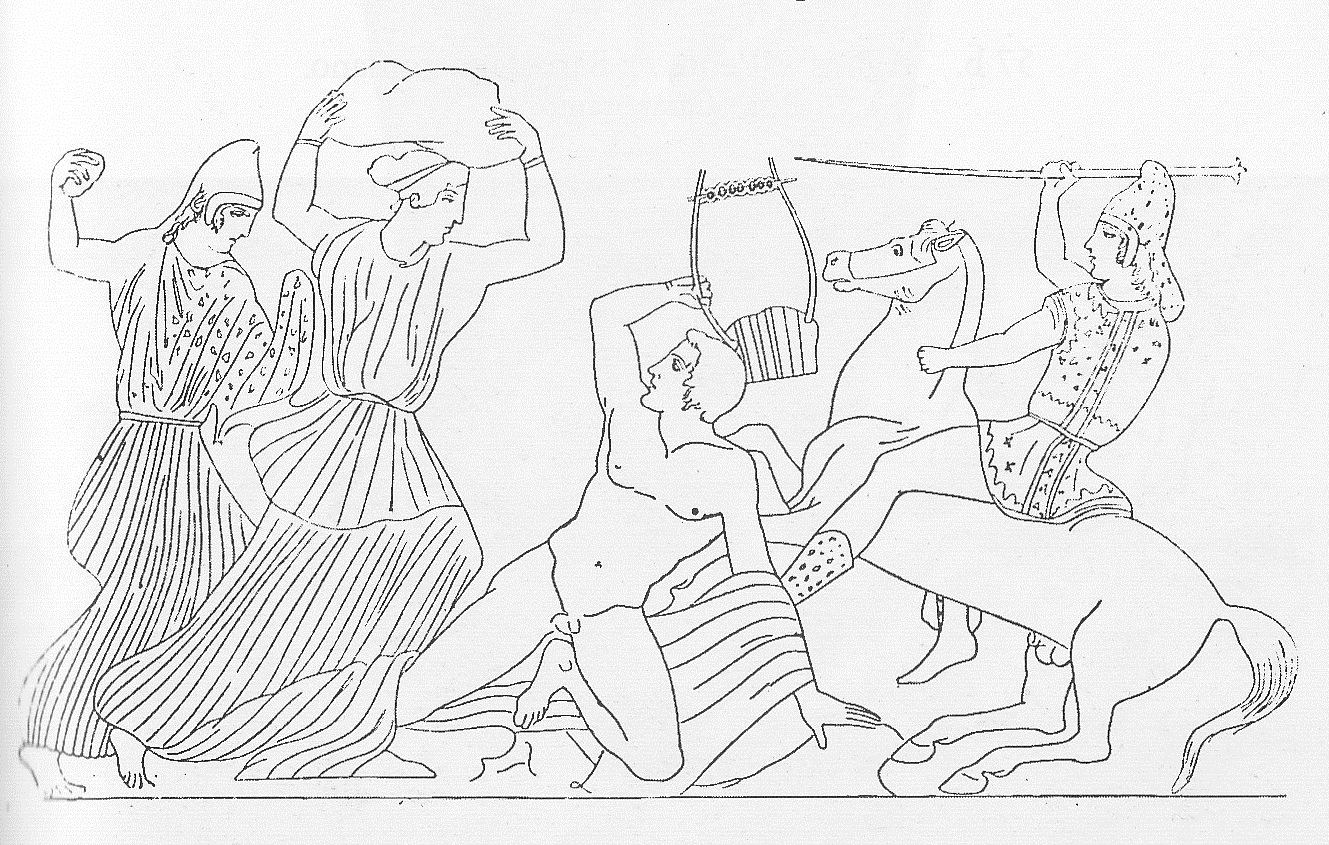
5_12.3 | Morte di Orfeo, stamnos attica a figure rosse, cosiddetto "Vaso da Chiusi", 450-425 a.C., disperso, già collezione Emil Braun (da Aby Warburg, Dürer und die italienische Antike, Hamburg 1905, tav. 1c).
5_12.3 | Death of Orpheus, Attic red-figure stamnos, known as “Vaso da Chiusi”, 450-425 B.C., lost, ex Emil Braun collection (from Aby Warburg, Durer und die italienische Antike, Hamburg 1905, plate 1c).

5_12.4 | Jacopo del Sellaio, Orfeo ed Euridice, pittura su cassone, 1471, Kiev, Khanenko Museum (da Aby Warburg, Dürer und die italienische Antike, Hamburg 1905, tav. 1d).
5_12.4 | Jacopo del Sellaio, Orpheus and Eurydice, painting on cassone, 1471,Kiev, Khanenko;Museum (from Aby Warburg, Durer und die italienische Antike, Hamburg 1905, plate 1d).
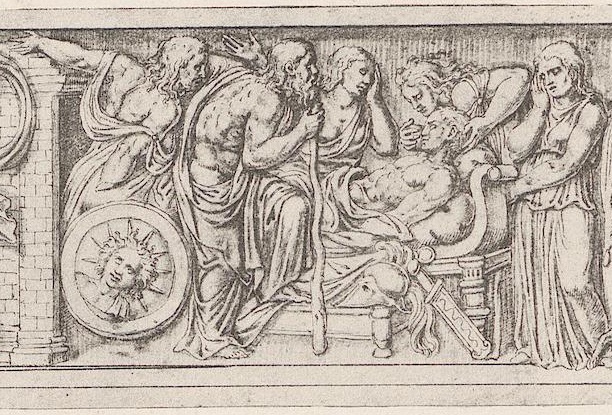
5_19 | Morte di Meleagro, disegno, dal bassorilievo su sarcofago romano di Villa Albani, 170 d.C. Codex Coburgensis, fol. 99, 1550-55,, Coburg, Kupferstichkabinett der Kunstsammlungen der Veste Coburg, Hz 2 (da C. Robert “Die antiken Sarkophagreliefs”, vol. III, 2, Berin 1904, tav. 92, ill. 278).
5_19 | Death of Meleager, drawing of the bas-relief of the Roman sarcophagus of Villa Albani, 170 A.C., Codex Coburgensis fol. 99, 1550-55, Coburg, Kupferstichkabinett der Kunstsammlungen der Veste Coburg, Hz 2 (from C. Robert “Die antiken Sarkophagreliefs”, vol. III, 2, Berin 1904, tav. 92, ill. 278).
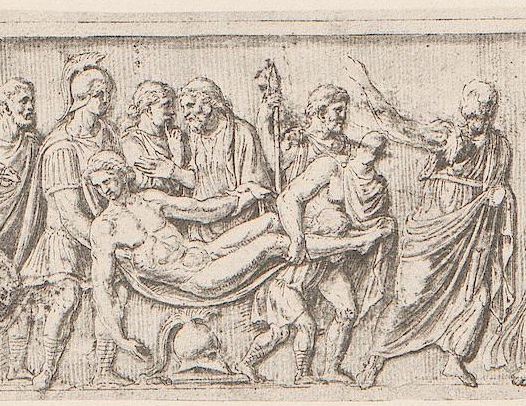
5_20 | Meleagro morente viene portato a casa, disegno dal bassorilievo su sarcofago romano perduto, già di Palazzo Barberini, 180-190 d.C., Codex Coburgensis, fol. 124, 1550-55, Coburg, Kupferstichkabinett der Kunstsammlungen der Veste Coburg, Hz 2 (da C. Robert “Die antiken Sarkophagreliefs”, vol. III, 2, Berin 1904, tav. 96, ill. 287).
5_20 | Dying Meleager, drawing of the bas-relief of the lost Roman sarcophagus from Palazzo Barberini, 180-190 A.C., Codex Coburgensis, fol. 124, 1550-55, Coburg, Kupferstichkabinett der Kunstsammlungen der Veste Coburg, Hz 2 (da C. Robert “Die antiken Sarkophagreliefs”, vol. III, 2, Berin 1904, tav. 96, ill. 287).
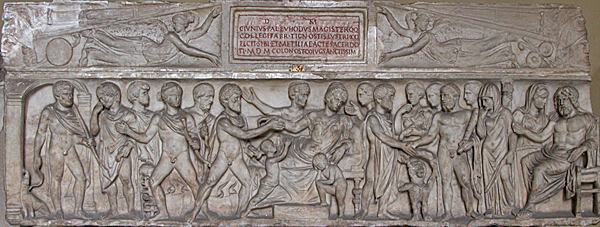
5_21 | Morte di Alcesti, marmo, bassorilievo sul sarcofago di Gaius Junius Euhodus e di Metilia, 160-170 d.C., Roma, Museo Chiaramonti.
5_21 | Dying Alcestis, marble, bas-relief on the sarcophagus of Gaius Junius Metilia, Euhodus, 160-170 A.C., Roma, Museo Chiaramonti.
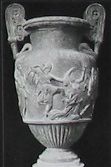
5_22 | Licurgo vince una menade, cratere a volute, marmo, 30-20 a.C., Roma, Musei Vaticani, Gallerie dei Candelabri.
5_22 | Lycourgus assaults a Maenad, volute krater, marble, 30-20 B.C., Roma, Musei Vaticani, Galleria dei Candelabri.

5_5 | Pedagogo, dal gruppo scultoreo dei Niobidi, marmo, copia romana da originale greco, IV-I sec. a.C., Firenze, Galleria degli Uffizi.
5_5 | The Pedagogue, from the sculpture group of the Niobidis, marble, Roman copy from a Greek original, IVth-Ist century B.C., Firenze, Galleria degli Uffizi.
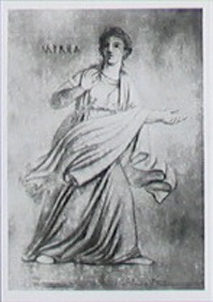
5_6 | Mirra fuggente, pittura parietale, da Tor Marancia, III sec. d.C., Roma, Musei Vaticani, Sala delle Nozze Aldobrandini.
5_6 | Myrrh fleeting, parietal painting, from Tor Marancia, 3rd century A.C., Roma, Musei Vaticani, Sala delle Nozze Aldobrandini.
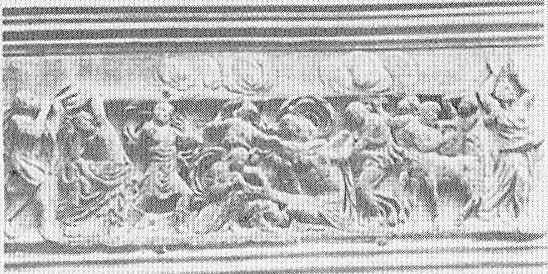
5_13 | Morte di Penteo, frammento di bassorilievo romano su sarcofago, 170-190 d.C., Roma, Palazzo Giustiniani.
5_13 | Death of Pentheus, marble, fragment of a bas-relief on a Roman sarcophagus, 170 -190 A.C., Roma Palazzo Giustiniani.
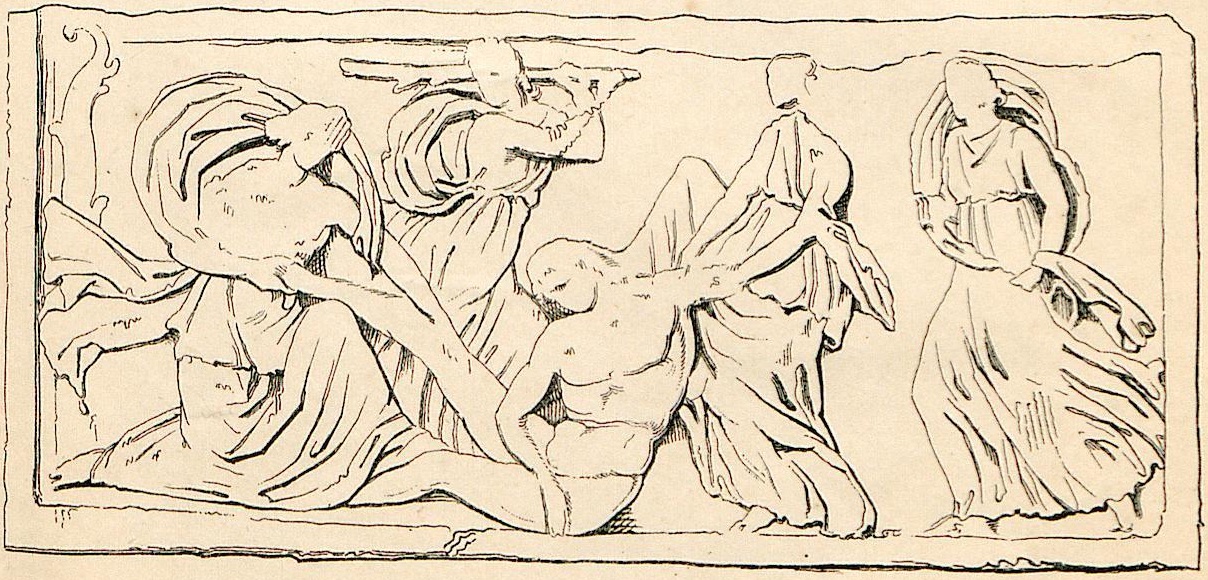
5_14 | Le menadi uccidono Penteo, disegno, dal coperchio del sarcofago di Tito Camurenus Myron del 150-160 d.C., Pisa, Camposanto (da O. Jahn, “Pentheus und die Mainaden”, Kiel 1841, tav. 3b).
5_14 | The Maenads kill Pentheus, drawing from the cover of the sarcophagus of Tito Camurenus Myron dated 150-160 A.C., Pisa, Camposanto (from O. Jahn, “Pentheus und die Mainaden”, Kiel 1841, plate 3b).
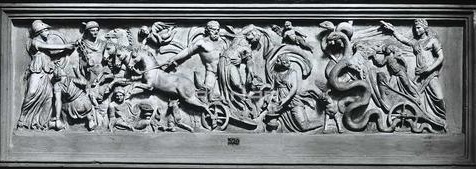
5_23 | Ratto di Proserpina, bassorilievo su sarcofago romano, 200-220 d.C., Roma, Musei Vaticani, Sala delle Muse.
5_23 | Rape of Proserpina, bas-relief of a Roman sarcophagus, 200-220 A.C., Roma, Musei Vaticani, Sala delle Muse.
